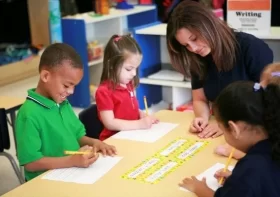Group kids by ability and subject not age, says gifted-education professor

Body:
Individualized Learning Paths: The conventional age-based grouping often assumes that children of the same age have similar academic abilities and interests. However, this is not always the case. By grouping kids according to their abilities, educators can create tailored learning paths for each student. This ensures that children can progress at their own pace, mastering concepts before moving on to more advanced material.
Catering to Diverse Learning Styles: Every child learns differently. Some may excel in mathematics but struggle with language arts, while others may thrive in creative subjects. Grouping students based on ability and subject allows for a more nuanced approach to education, enabling teachers to adapt their methods to accommodate various learning styles. This fosters a supportive and inclusive learning environment where each child can shine in their areas of strength.
Fostering a Growth Mindset: Traditional age-based grouping can inadvertently create a fixed mindset, where students may feel compelled to meet predetermined benchmarks. On the contrary, grouping by ability and subject encourages a growth mindset, emphasizing continuous improvement and the mastery of skills. This shift in perspective can enhance students’ self-esteem and motivation, as they focus on personal growth rather than societal expectations.
Addressing Gifted and Special Needs: Gifted students often find themselves under-challenged in traditional classrooms, while those with special needs may struggle to keep up. Grouping students based on ability allows educators to identify and address these diverse needs more effectively. Gifted students can be placed in accelerated programs, while those requiring additional support can receive targeted assistance, ensuring that every child receives an education tailored to their capabilities.
Cross-Age Collaboration: By grouping students according to their subject proficiency rather than age, opportunities for cross-age collaboration arise. Students with similar interests and abilities can work together, fostering a sense of community and peer support. This collaborative approach not only enriches the learning experience but also promotes social and emotional development as students interact with peers of different ages.
Preparation for Real-World Challenges: The real world does not organize tasks or problems based on age. In the professional realm, individuals are often required to collaborate with people of varying ages and expertise. Grouping students by ability and subject prepares them for these real-world scenarios, equipping them with the skills needed to work effectively in diverse teams and adapt to the challenges of a rapidly changing world.
Conclusion:
In reimagining education, the gifted-education professor advocates for a departure from the traditional age-based grouping system. By organizing students based on their abilities and interests, educators can unlock the full potential of each child, providing a personalized and dynamic learning experience. This paradigm shift not only addresses the diverse needs of students but also fosters a growth mindset and prepares them for the complexities of the real world. As education continues to evolve, embracing innovative approaches like this may pave the way for a more inclusive, effective, and student-centric educational system.




Leave a Reply